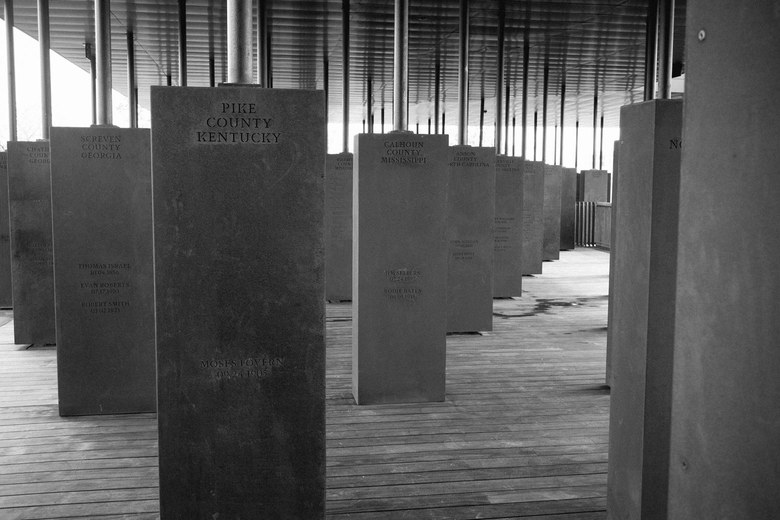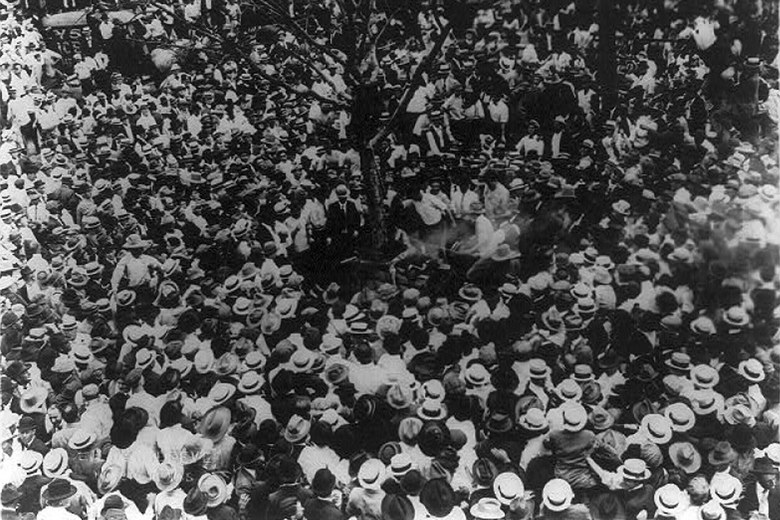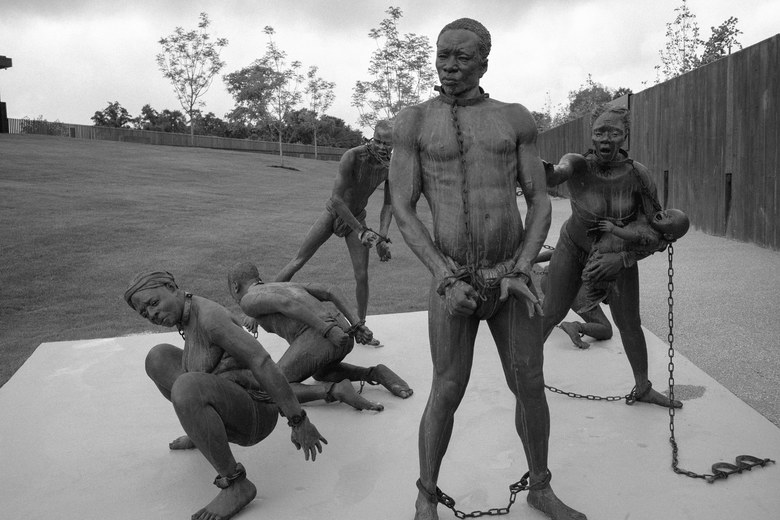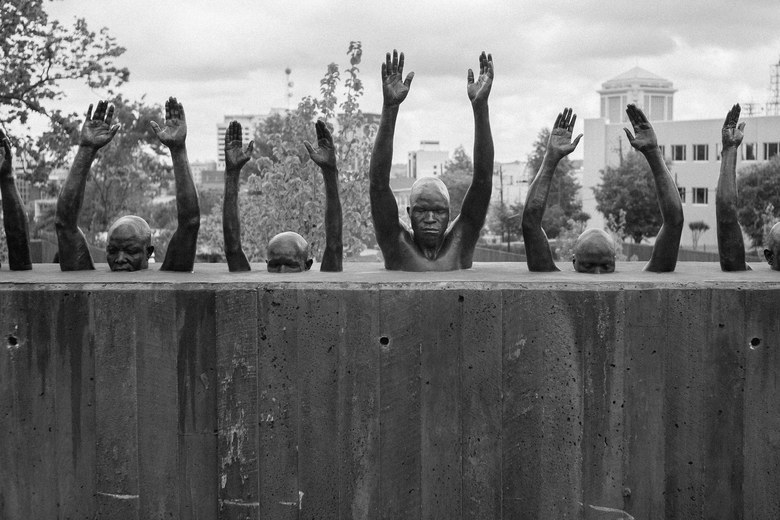MONTGOMERY, Alabama—On Thursday, the National Memorial for Peace and Justice opened in Montgomery to remember the thousands of Americans who were hanged, burned, or otherwise murdered by white mobs. The memorial sits just a short drive from the state capitol building, where three days earlier, the state of Alabama had celebrated Confederate Memorial Day, an official state holiday. It’s a city where slave traders once sold children for profit, and where slave owners would later launch a rebellion, and form a government, on the conviction that slavery was necessary, inviolable, and good. It’s the same city where, in living memory, a sitting governor pledged his total commitment to segregation in the face of an unprecedented civil rights struggle, and where—in the present—more than 30 percent of black people in the area live under the poverty line.
The central structure of the memorial is a looming cloister where 800 steel columns hang from the roof. On each column is a state, a county, and the names of everyone lynched there, along with the dates of their deaths. The columns start at eye level, but as you walk through the memorial, the floor descends and the structures hang like so many victims. You, the visitor, become a kind of witness to the ritualistic murders that claimed at least 4,000 black Americans between 1877 and 1950: from the collapse of Reconstruction to the beginning of the end of Jim Crow. The scale of that killing becomes clear in an adjacent room, where replicas of those hanging steel structures are placed like coffins on the ground, arranged in alphabetical order for visitors who want to find the one that marks their town or county.
For me, two markers mattered: Ware County, Georgia, and Gadsden County, Florida, where my mother and father are from, respectively. Four people were lynched in Ware and four people in Gadsden—the earliest in 1881, the latest in 1941. Walter Wilkins, killed on June 27, 1908, in Ware County’s seat of Waycross, had been accused of assaulting a young white girl. It is difficult, for me, to express the feeling of finding the columns that mark your origins—seeing the names of the victims and imagining the terror and fear that must have coursed through those communities. And thinking, too, that the most recent killings happened within living memory of people you knew, or who knew your parents and grandparents.
Racial hierarchy and inequality still exist today, but Jim Crow is gone and the public, socially sanctioned violence that defined the lynching era has largely disappeared. Which may lead some to ask why? Why dwell on this painful period of American history? Why fight to bring this unspeakable violence into the national consciousness? And why work to integrate it into public memory when lynching remains an incredibly fraught metaphor for racial conflict, with heavy symbolic baggage that weighs on any conversation around the subject?
The answer is straightforward. We live in a moment when racism—explicit and unapologetic—has returned to a prominent place in American politics, both endorsed by and propagated through the Oval Office. And in that environment, a memorial to racial terrorism—one which indicts perpetrators as much as it honors victims—is the kind of provocation that we need, a vital and powerful statement against our national tendency to willful amnesia.
The victims of lynching and racial terrorism deserve a memorial that makes plain the scale of the offense and the magnitude of the crime. The communities in question deserve a chance to reckon with the weight of their history. And Americans writ large need an opportunity to grapple with this period as we struggle to understand a present that contains disturbing echoes of our not-too-distant past.

Neither the memorial nor the museum shies away from calling lynching what it was—“racial terror violence.” Terrorism is a loaded term, but Bryan Stevenson, whose nonprofit Equal Justice Initiative organized and built the memorial and the accompanying Legacy Museum, embraces it and its implications. “When a black person was lynched, they were not just lynching that person, they were targeting the entire African-American community,” said Stevenson. “Nobody thinks that the 9/11 perpetrators were just trying to kill only the people who worked at the World Trade Tower. They were trying to terrorize the rest of us, and that’s the reason why we felt justified in fighting a war. I look at the exodus of 6 million people who flee the American South during this period as victims of lynching, even though they weren’t strung up. And in that respect, you have to use the word terrorism to characterize this violence.”
Both the memorial and museum show how widespread and wanton this campaign of violence could be. “Elbert Williams was lynched in Brownsville, Tennessee, in 1940 for working to register black voters as part of the local NAACP. Reverend T.A. Allen was lynched in Hernando, Mississippi, in 1935 for organizing local sharecroppers. Jack Turner was lynched in Butler, Alabama, in 1882 for organizing black voters in Choctaw County.”* By highlighting “offenses” like labor and political organizing in addition to alleged sexual violence against white women—the most remembered casus belli for lynching—the memorial reminds us that this violence was first and foremost a form of social control, a way to preserve race hierarchy against the claims and actions of black Americans. Many were killed with the approval of state authorities. Few committed any real crime. The murderers themselves escaped punishment or accountability. Some participants, like future senator Ben Tillman of South Carolina, would go on to Washington.
The terror wasn’t just for blacks accused of supposedly unacceptable conduct in their contact with whites. In her investigation of the lynching of three Memphis grocers—Thomas Moss, Calvin McDowell, and William Stewart—pioneering journalist and anti-lynching activist Ida B. Wells concluded that their alleged offense was simply success. The lynching had been “an excuse to get rid of Negroes who were acquiring wealth and property and thus keep the race terrorized.” An April 1919 edition of the Chicago Defender records a lynching in Blakely, Georgia, where Pvt. William Little—a soldier returning from the war in Europe—was accosted by whites who demanded he remove his uniform. Several weeks later, after warnings that he had worn his Army garb for “too long,” he was found dead, beaten by a mob.
These murders weren’t driven by a small group of virulent racists but were embraced by most white communities in which they occurred. They were communal acts that imparted meaning to spectators and participants alike. What is made clear in the museum is that the history of lynching is for white Americans as much as it is black ones. It is a history of how the white South constituted itself through communal violence, creating and policing the borders of its racial identity. Lynching wasn’t just a way to enforce caste relations between blacks and whites, it was also a tool white Southerners used to define the meaning of their whiteness.
You can see what this looked like in the large body of lynching photographs, some of which are presented in the museum as evidence of lynching’s broad acceptance among white Southerners. The pictures had a purpose: They were circulated by perpetrators as mementos, souvenirs, and propaganda, meant to warn blacks of the danger of stepping out of line, no matter how innocuous the offense. A 1935 photograph from the lynching of Rubin Stacy, a young homeless tenant farmer, shows the perpetrators and their families in comfortable, seemingly well-constructed clothing. The men are wearing slacks, the women and girls are in dresses. At their center is Stacy’s lifeless body, hanging from a tree, his hands cuffed. One of the girls is smiling. A 1930 photograph from the lynchings of Thomas Shipp and Abram Smith, both 19, shows a crowd that is large, well-dressed, and visibly interested in the grim spectacle. Another photograph—from the 1916 lynching of 17-year-old Jesse Washington in Waco, Texas—shows a crowd of thousands watching as his body burns and smolders.

White communities celebrated these lynchings in the local press, as documented in 100 Years of Lynchings, a collection of contemporaneous news accounts. “Zachariah Walker, a negro desperado, was carried on a cot from the hospital here last night and burned to a crisp by a frenzied mob of men and boys on a fire which they ignited about a half mile from town,” crowedthe Montgomery Advertiser in a story dated Aug. 15, 1911. Politicians were often enthusiastic supporters of these efforts. Commenting on a recent lynching in his state, Gov.
Cole Blease of South Carolina told crowds that he would rather have “resigned the office,” and “led the mob” himself, than deter any white man from punishing “that nigger brute.”
This was more than gruesome titillation or curiosity. The age of lynching emerged at a time when much of the country was preoccupied with the decline of traditional morality, represented by urbanization and the growing autonomy of women. This larger context is outside the scope of the museum—which turns its attention to the victims—but it is an important part of understanding the lynching era and why it matters for the present. In the white South, that preoccupation blended with patriarchal norms, evangelical religion, and white supremacy to produce a noxious brew where, as historian Amy Louise Wood writes in Lynching and Spectacle: Witnessing Racial Violence in America, 1890–1940, “white southerners … conceptualized the threat of black enfranchisement and autonomy as … a dire moral threat to white purity, literally a physical assault on white homes and white women.” And in this vision, “black men came to personify the moral corruption that they believed to be the root cause of social disorder.”

Lynchings served two purposes: They both preserved white dominance against the prospect of black equality and restored the presumed moral status of white communities by eliminating threats to white purity and virtue as well as white authority. These killings often took a ritualistic cast. “Lynch mobs at times gave their victims time to pray and, more frequently, wrought confessions from them,” writes Wood. Likewise, lynch mobs paid close attention to torment and suffering, “practices that publicly rehearsed narratives of human sin and divine judgment”—well known in an age of public, deeply held Christianity. It is not without meaning that lynching defenders condemned victims as “demons,” “fiends,” and “brutes,” nor is it coincidence that, in her defense of lynching, prominent temperance activist, suffragette, and future U.S senator Rebecca Latimer Felton thundered that if “there is not enough religion in the pulpits to organize a crusade against sin … nor manhood enough in the nation to put a sheltering arm about innocence and virtue” then “lynch a thousand times a week if necessary.”
With brutal, unspeakable violence, white men affirmed their manhood, white communities affirmed their virtue, and the white South, as a whole, affirmed its power. To murder with impunity, in full view of the public, is to claim total authority. On the other side, both black men and black women were shown their essential powerlessness in Southern society. And the extent to which black women were lynched—Mary Turner, for instance was killed with her unborn child for complaining about the lynching of her husband—served to underscore the scant value attached to their lives and “womanly virtue.” If the master-slave relations of the antebellum South were shattered by the Civil War and Reconstruction, then lynching helped recreate them, albeit on more “democratic lines,” as all white Southerners—and not just a select, propertied few—could claim the right to kill. Lynching dramatized the South’s emerging caste system at the same time that it defined its terms.
That rigid caste system may be gone, but the central narrative of lynching—the lie of inherent black criminality—still shapes public life. Just weeks ago, 14-year-old Brennan Walker was shot at after knocking on a door in the predominantly white Rochester Hills, Michigan. The woman at the door thought he was there to rob them, and her husband, who heard her screams, ran down with his shotgun. Walker had simply stopped, on his way to school, to ask for directions. He was lucky. In 2013, 19-year-old Renisha McBride knocked on a door in a Dearborn Heights neighborhood, seeking help after a car crash. The homeowner, Theodore Wafer, opened his door and fired his shotgun, killing her. Compare both incidents to a lynching account presented at the memorial: “A black man was lynched in Millersburg, Ohio, in 1892 for ‘standing around’ in a white neighborhood.”
The specter of the black criminal continues to weigh on our justice system. Stevenson is quick to note that the most reliable predictor of a death penalty sentence is still the race of the victim, not the perpetrator. Black killers of white victims are far more likely to receive a death sentence than black killers of black people.
Lynching echoes in other ways. Our politics are in the grip of a backlash defined, in large part, by deep racial entitlement on the part of many white Americans. Indeed, racial violence—or the promise of such—remains a potent tool for defining the boundaries of white racial community. As a candidate for president, Donald Trump promised state action against Hispanic immigrants and Muslim refugees. Not as punishment but as defense—a way to keep America free of people that, in his view, cannot assimilate. How did he describe these groups? As “rapists,” criminals, and drug dealers—dangerous gang members who defile and kill innocent American women. Far from repelling voters, this language primed and activated racial fear and resentment among many white voters, supercharging its electoral potency. Trump wasn’t just defining an enemy, he was speaking a language of racial threat—of purity and morality—that has its roots in the lynching era.Perhaps, had white Americans in particular possessed a better understanding of the lynching era and what it entailed, they would have viewed Trump’s message of past greatness with appropriate skepticism. “I think about the history, and I realize we’ve never said, ‘Never again,’ ” Stephenson said. “We didn’t say, ‘Never again’ at the end of enslavement. We didn’t do it at the end of lynching, at the end of segregation. And because we haven’t actually articulated the commitment, things keep happening. We keep replicating new forms of bigotry and discrimination that get applied to people of color and to African Americans in particular, that ideology of white supremacy survives.”
The National Memorial for Peace and Justice forces Americans into a difficult but necessary confrontation over the depths of our racial divide. It’s a rebuke to the whitewashed history of “Make America Great Again” as well as the naïve “post-racialism” of the recent past. And it tries to push the story forward. A statue titled “Raise Up” shows a row of men, their heads and shoulders coming out of stone, their hands raised above their heads. You don’t need a guide to know what they’re saying. Hands up, don’t shoot. Placed after the central monuments of the memorial, it connects the racial violence of the past to the racial violence of the present, challenging the triumphant narratives that make today’s America—and today’s Americans—fundamentally different than those who lived before.

It’s reminiscent of journalist Isabel Wilkerson’s comparison between lynchings and police shootings, following the unrest in Ferguson, Missouri, in 2014. “The rate of police killings of black Americans is nearly the same as the rate of lynchings in the early decades of the 20th century,” wrote Wilkerson, placing those events on a continuum with the violence that drove the “Great Migrations” of the 20th century. “The haunting symmetry of a death every three or four days links us to an uglier time that many would prefer not to think about, but which reminds us that the devaluation of black life is as old as the nation itself and has yet to be confronted.”
There are other potent connections between the past and the present. The public nature of lynching echoes in the ubiquitous videos of police assaults and police killings. Like lynching photographs, they have sparked outrage and galvanized activists, building political will for criminal justice reform. But they also turn trauma into endlessly repeated spectacle, rehashing the initial injury and reminding black people of their tenuous place within American society.
There is some danger in the directness of these comparisons. To use lynching too much as a metaphor is to wear it down, robbing it of its specificity and meaning. A phrase like “high-tech lynching”—or rhetoric that compares harsh criticism to a “lynch mob”—obscures far more than it illuminates. Still, there’s reason to keep lynching as a metaphor and analytical tool; as the Legacy Museum shows, there are too many parallels between that era of racial terrorism and the current struggles against police brutality and white racial backlash to ignore.
But what do we do with those connections? The memorial and museum suggest one approach. Both are interactive in a sense. Individual communities can claim one of the individual monuments that make up the memorial. They can remove it to their town or county and erect it as a memorial to their particular victims of lynching. Over time, visitors will be able to see who has taken a marker and who hasn’t, who is reckoning with their history and who isn’t. Stevenson also hopes that after experiencing the monuments and exhibits, individuals are primed to act. He wants the country to look at racial terrorism and say, “Never again,” and in pursuit of that end, the Equal Justice Initiative will provide information to help visitors register to vote or sign petitions relating to racial justice and reform.
It’s both a powerful gesture—connecting this history to the politics of today—and one that doesn’t quite fit the sheer radicalism of this project. The National Memorial for Peace and Justice isn’t just a memorial. It is an indictment of the United States and its ongoing commitment to racial hierarchy. It argues, explicitly, that white supremacy is fundamental to the structure of this society. And it suggests that our only option for uprooting those evils is a radical correction from our present course.
Correction, May 3, 2018: This story originally misstated that Elbert Williams was lynched in 1914. The correct date is 1940.
Jamelle Bouie is Slate’s chief political correspondent.


Spread the word